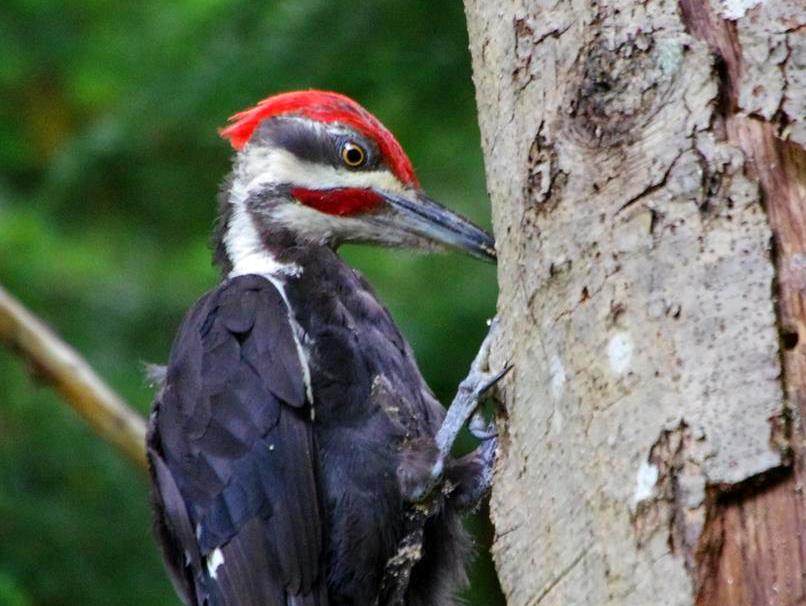Pileated Woodpecker (Dryocopus pileatus)
The majestic Pileated Woodpecker is North America’s largest woodpecker, due to the unfortunate, virtual extinction of the Ivory-billed Woodpecker. If you listen closely in the forest, you will be sure to hear the pileated calling or drumming, and if you’re lucky enough, you may even catch a glimpse of it flying by or hammering on a snag.
Photo by George Mason
Why they Matter to Us
Pileated Woodpeckers
are majestic birds that are fascinating to watch and a welcome visitor at any suet feeder
spark the interest of many birders and wildlife photographers
play a crucial role in forest ecosystems: their abandoned nest holes offer shelter and nesting habitat for many species of wildlife, including small owls, ducks, bats, and even pine martens
consume large numbers of wood-boring insects that damage trees
How You Can Help
Support protected areas in the Edmonton region (such as EALT!). You can donate or volunteer your time to help with conservation efforts.
Our Boisvert’s GreenWoods Conservation Lands is home to nesting Pileated Woodpeckers. This natural area conserves important old growth forest where numerous species of woodpeckers have plenty of snags – crawling with bugs – to feast on.
If you live near a ravine, or any woodpecker habitat, you can hang a suet feeder on a tree to help provide food for Pileated Woodpeckers.
Leave dead or dying trees standing (rather than knocking them down) in natural areas and green spaces. They provide lots of food for woodpeckers.
How to Identify
Identify by Sight
To identify the Pileated Woodpecker, look for these distinguishing features:
solid black back
white stripes on the face
flaming red crest
long chisel-like bill
males have a red mustache
Identify in Flight
To identify the Pileated Woodpecker as it flies by, look for these clues:
undulating flight pattern
extensive white underwings
small white crescents on upper side of wings
Identify by Sound
Pileated Woodpeckers have a loud, shrill piping call with notes that sound like ‘wuk’ or ‘cuk’. It is similar to the Northern Flicker’s call, but is less even tone, with changing emphasis throughout. They also make a deep drumming sound when feeding or when trying to attract a mate in the spring.
Click here to listen to the many sounds of a Pileated Woodpecker.
Identify by Sign
You can tell a Pileated Woodpecker lives in the area by their uniquely distinguishable rectangular holes left in snags where they feed. Other common woodpecker species in Alberta leave smaller, round holes when they excavate for bugs.
Where to Find
Pileated Woodpeckers are found throughout most of Alberta, in forested regions. They live in mature forest and young forests which are scattered with a supply of large dead trees. You can find these woodpeckers right in Edmonton’s river valley!
Pileated Woodpeckers are residents and do not migrate in the winter. They have plenty of food sources to sustain them year round.
Social Life
Pileated Woodpecker pairs stay together in their territory all year.
They defend their territory, only tolerating new arrivals in the winter months.
Food Chain
Food: mainly ants and other wood-boring insects; also fruits, nuts, and berries.
Predators to the nest: martens, weasels, and squirrels, but the adults will guard their nest – which was observed by a photographer watching a nest and an intruding squirrel. Click here to see photos.
Predators to the adult birds: some hawk and owl species.
Fun Facts
The oldest known Pileated Woodpecker was 12 years, 11 months old.
You can pronounce ‘pileated’ two ways, with a short ‘I’ sound (pill-ee-ated) or a long ‘I’ sound (pile-ee-ated).
A group of Pileated Woodpeckers is called a “crown”.
A woodpecker’s head moves 6 m/s at each peck enduring a deceleration more than 1,000 times that of gravity. Scientists have been studying woodpeckers’ skulls to find out how the birds can peck with such force, without resulting in injury to their brain. This research may be helpful in designing more effective head protection for people.
Sources
ABMI (2015). Pileated Woodpecker (Dryocopus pileatus). ABMI Species Website, version 3.0.
Readers Digest (1990) Book of North American Birds. Pleasantville, NY: The Readers Digest Association, Inc.
Pileated Woodpecker, from The Cornell Lab of Ornithology’s All About Birds
How woodpeckers avoid head injury, from Science and technology; BBC News






